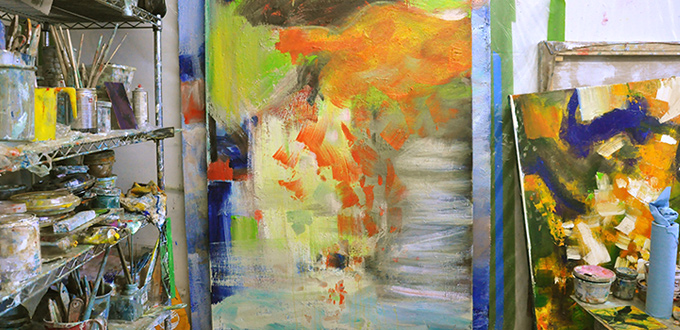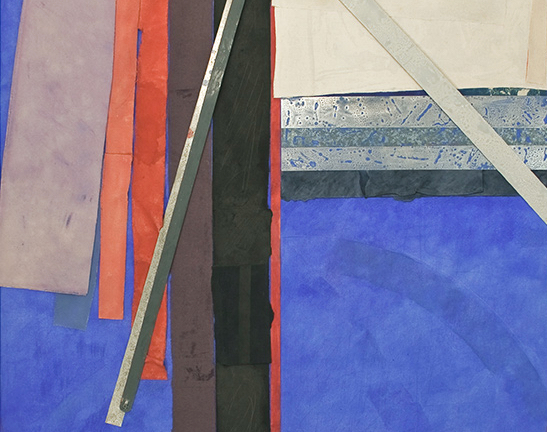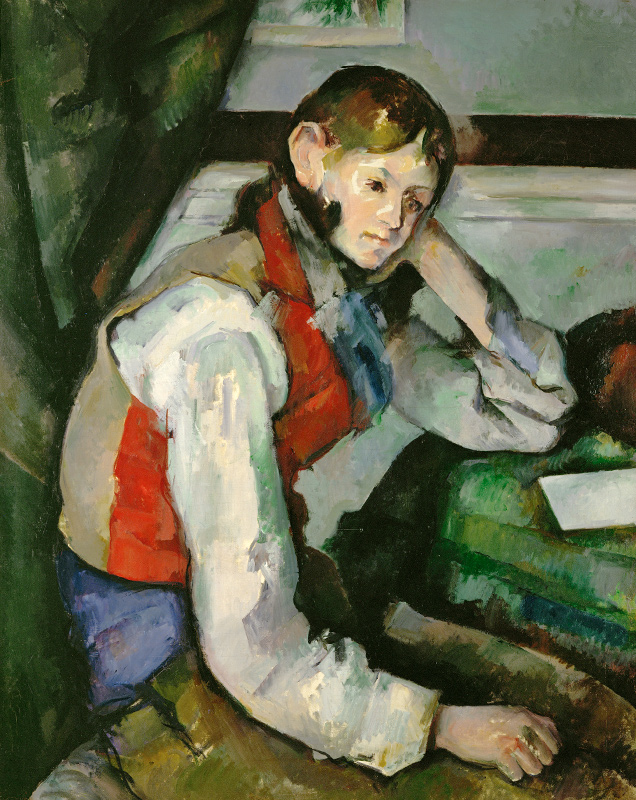
Ira Goldberg: What is art?
Knox Martin: Once I gave a talk on art to a very mixed audience in Oregon: some college students, journalists, and collectors. Someone in the audience said, Sir, nobody knows what art is. Tolstoy said that art is subjective. I replied, What does he know?
Art is a very specific thing made by artists. I had on the lectern a reproduction of Cézanne’s Boy with the Red Waistcoat. Pointing to the reproduction, I said, This is art. Every museum in the world would agree. There are over 500 books on Cézanne. Who else thought this was art? Dufy, Gauguin, Braque, Picasso, Matisse, and de Kooning. Matisse said, If Cézanne’s right, I’m right. Picasso said, Cézanne is my father. De Kooning said, Everyone thinks I am a super-cubist, but it is Cézanne that I work through. This has changed the world. Everything has changed because of this painter. This is art. I can talk about it. I can point to it. And I can do it Now, a gentleman, his name was Shore, had collected some of my work. There were three paintings of mine on the walls. So I said, I can point to art, I can talk about it, and I can do it. Look at these paintings. This is art. It doesn’t pretend to be anything else. Usually with an audience, once you finish, people come up to you. But, in this case, there was a strange avoidance. It was like, how dare you show us in these very simple terms what art is.
How does the viewer perceive art without that understanding? Don’t people tend to bring their experience to their viewing of art?
Whatever the viewer brings to the work should be swept away by what the work is. In fact, many so-called works of art, like illustrations, only provoke what’s already inside the viewer. They push buttons. A big button pusher just went for 120 million dollars, The Scream by Edvard Munch, who has nothing to do with art or painting in any possible way. Munch is the Mickey Mouse of the art world. That painting takes its rank alongside the Campbell’s soup can by Warhol or some other iconic thing that people see. They don’t have to pay any dues to see it.
What do you mean by dues?
If you’re going to talk about art, you’ve got to talk to an artist, and I mean an artist. You’ve got to talk to someone at the level of a de Kooning, the only other artist that I’ve really been able to talk to. Cézanne has said about art whatever Matisse has said about art. Matisse would refer to Nicolas Poussin. Nicolas Poussin would refer to the Venetian School. In a strange way, at the end of everything, art is like an internal joke among artists. The vast umbrella of the world of art covers everything.
But what specifically does an artist do? An artist makes art, and he demands the credentials of art. He’s investigated art, and he knows what art is. It’s not anatomy; it’s not proportions; it’s not brilliant execution; it’s not photographic likeness; it’s not journalism; it’s not individual pain. It is opening up the elements that make those pieces of art perpetually fresh, timeless.
Okay. So now you have just answered the question, What is an artist?
Let’s say it this way: In the early days, when I was a student at the Art Students League, I would come from the museum filled with what I had just seen and talk to the instructor, my authority. He didn’t know what I was talking about. I was talking about art. Instantly, the barrier was put up, and he promoted whatever he was involved with. Instructors could only point in the general direction of art. But they could also be bombastic about say, social realism, and I’d say that’s journalism.
But to them, it’s something pertinent to their own experience. What they’re calling it, they thoroughly believe it is. What makes you right?
All you have to do is run through a list of what you’re involved with, what you’re liking. When people come to my class, I ask who they’re interested in. If they mention any of the British painters—Frances Bacon, Turner, Sir Joshua Reynolds, Gainsborough—I say, Go get your money back. This is not the place for you. In other words, you are insurmountable, an insurmountable barrier. If someone comes over to me and raves about Mexican artists—Siqueiros, Orozco, Diego Rivera—I say, You’re not talking about art. You’re talking about social illustration.
Why would they be moved by that art?
Because people are moved by Mickey Mouse or Donald Duck or Flash Gordon.
But there are some people who are moved by Mickey Mouse and Donald Duck and also by Picasso’s Guernica.
No, no.
There cannot be people who have an appreciation for both? You’ve said before, It’s not just what the art is, it is what the viewer brings to it.
No, what the viewer brings to art is what kills it. Art teaches you. You look at art and things are swept away. If you bring intellectualism to it, or an idea, you’ve modified what the art does. Life is so short. What do you take with you? What do you spend your hours with? What do you look at? What do you do? Matisse said that every morning he would read poetry, and that would be like a breath of air. He would rouse himself by that. He would look up at the Cézanne that he had on the wall, right? And then he would do the thing. If you have an allotted time, a chart and a map, you say, What could I do with my life? My mother once said to me when I was a kid, Show me who your friends are and I’ll show you who you are. I have in every room a Cézanne, a Watteau. I have Titian books, Matisse books. I have the greatest poetry of the world, and the great music. I listen to Mozart, or Bach, or Beethoven. In other words, what greater thing can you fill your life with than the greatest things that man has ever done?
You speak in terms of recognizing art. In your view, art tells you what it is or what it is not. You’re saying you don’t look at art through any kind of filter?
Art will tell you constantly. Paul Valéry writes that Stéphane Mallarmé says, Whatever you have, it isn’t sufficient to have me. You have to work at me to have me. If you do an anatomical study, there are people who will jump around over a joint or a knuckle, and say, Well, the anatomy is not exactly right. Someone else will say, Oh, my God, I can’t do that. Will anatomy enable you to do a landscape or a still-life painting?
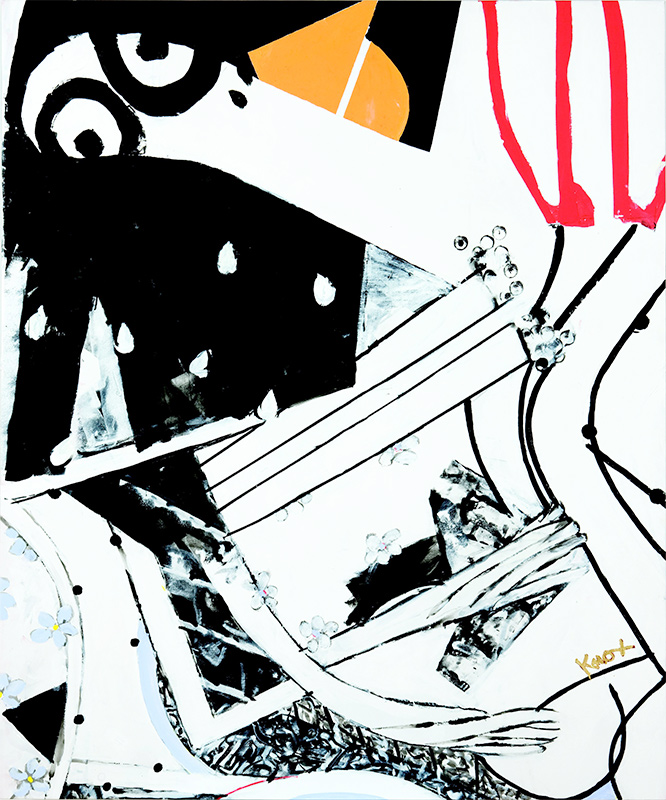
In other words, there are people who will be impressed based on the intricacy of accurate rendering and the skill it takes to do it.
Robert Beverly Hale was sitting in the office, and he looked up at me and said, Knox, I just did it for the first time in my life. It was a year before the end of his life. There, on an envelope, is a drawing of a hand. It had no relationship to the edges of the envelope, position of the drawing was arbitrary, no relation to top or bottom or sides! It was anatomy, period. It wasn’t art. It had nothing to do with art. Nothing. Zero.
Why would Hale necessarily think that it had something to do with art?
He never said that. He said, I’ve just done it. Anatomy.
The way you describe it, Hale felt it was a benchmark of his own progress?
His own thing. Now, that could have been a million other things. Like Picasso said, I am a prisoner of my canvas; it tells me what to do. It is sort of like a jump into the word haptic.
Elaborate.
Haptic is like a child picking up a crayon and to him it is a stick. He looks at a piece of paper and the concept is a sky. So he starts dragging the crayon across the paper and there emits from the edge of this crayon a blue scraggly line with the paper coming through. He goes across the whole page like that and he makes that as a metaphor for the sky. He doesn’t think it is a metaphor; he thinks that’s the sky. See? That’s haptic.
Like intuitive?
Not intuitive, but a feeling, a grosser level, a base level of feeling. I wish you had heard my talk on the Guernica. I went into detail and showed where everything was haptic. The composition of the Guernica was taken from a big painting by Rubens called The Horrors of War—people falling out of windows, buildings burning, books burning. In the beginning the bull faced inward, and then Picasso changed it and brought a bird out this way. See the woman reaching out with a light trying to illuminate this scene, the impaled spear on the figure and then some dashes on the statue at her feet? The woman with the dead child on her arm is one of the most amazing images I’ve ever seen. The woman is screaming.
In the painting by de Kooning called Pink Angels, he takes the face of the woman screaming, and he puts it in the bottom of the painting. It is related to the Guernica. The Guernica was modern art. Pollock, de Kooning, every painter dreamed of doing their own Guernica. The world of art was Guernica: the most amazing, pervasive piece of work that has ever been done.
So we pointed out in the painting where a shape going this way gave birth to a shape going that way, and the light here gave birth to a dark next to it. A thin line gave birth to a fatter line. The space in between was as charged as the forms it defined. Each piece was subject to the true freshness of the metaphor, which Aristotle talks about being the home of genius. The metaphor is at the heart of art itself. Aristotle also talks about the dead metaphor. That’s what most academic things—the Hudson River School and realists—are dealing with. They are dealing with dead metaphor that will push someone’s buttons. The Guernica would be a blank.
Why do these people work in, as you say, dead metaphor?
If you talk to all these people who don’t see art, as well as artists, you can hold up a Cézanne and ask, Do you see this? Do you understand it? They would have no awareness whatsoever. No inkling of it in any way, shape, or form. I’m talking about ninety-eight percent of people who are involved with art collecting. The two guys who once came here, after a de Kooning show, to discuss art and de Kooning, sat in front of the drawing and never looked at it. People come in here who never look at anything. They can’t afford to.
What do you mean?
There was a young lady who asked to see my work. So I said sure. I had a bunch of the black and whites that I’ve worked on for years, stack upon stack in another room. I said to her, What does it mean to you? Silence. She finally said, Can I pay you to be my teacher? I said, You can enroll at the Art Students League and hear me talk. She enrolled at the Art Students League. Six months later she came here, and she said, Oh, my God. Oh, my God. Oh, my God. She couldn’t see it before that. It had been invisible to her.
Does art have meaning?
Art is the continued creation of the world. That’s what art does. Art does not reflect the world. Joyce said, I go to encounter for the millionth time the reality of experience and to forge in the smithy of my soul the uncreated conscience of my race. I mean from the very simple to the most complex things in the world. For the simplest thing in the world, the first person to make amoebic shapes was Miró. Before Miró, nobody had a freeform coffee table or swimming pool. Swimming pools all over the world had been either round, square, or rectangular. Miró comes along, and all the big resort centers built freeform amoeba-shape swimming pools.

Could that amoebic shape, as you talk about it, have come about prior to the discovery of the amoeba?
No, this was a correlate. Miró did this. The guy that got close to it in a stupid way was one of the worst Russian painters in the world, Kandinsky. He began to do amoebic shapes, like microscope shapes, but it is all naturalistic.
Could those shapes have come about had it not been for scientific discoveries made during that time?
No.
So there is no correlation between the invention of photography and the emergence of impressionism or the discoveries of science and Einstein’s particle theory and the emergence of cubism. The fact that they are happening at the same time is purely coincidental?
It had nothing to do with it.
Quantum mechanics?
No, quantum mechanics. I’ve gone into it and looked into it. That was what I was going to be, a scientist. Until I met the scientists and I said, Whoa.

Wait a minute. The fact that there is an awareness of a structure of the world previously unknown has no effect on how artists think?
No, you’re talking about reflection now.
No, I’m talking about awareness.
Awareness is a whole kind of thing. To be aware is a very different level. It is not to be confused with what you know. Awareness is perception at the edge of things.
Was Einstein aware?
Understand this: Science is a how-to-do-it book. Science is not creation. However, science is the creation of man, as well as mathematics, as well as deities, as well as myth, stories, music, painting, everything. In other words, the center of this whole thing is man. Pissarro went to the Bahamas to paint and he painted the Bahamas from what he knew from the old masters in Europe. He came back and he painted background in the Bahamas in sepia. The water was a sepia brown. He was painting the varnish on paintings. That’s what painting had become; it was all brown and varnish. They started to paint the stuff in sepia instead of bright colors that these things were actually done in.
A lot of photography used sepia then.
It made it sanguine; it made it acceptable. It made it part of the nostalgia. When T.S. Elliot published a poem in 1915, The Love Story of J. Alfred Prufrock, it changed the world. Everything changed. And the guy who was closest to that was a person who had contact with the most amazing people in the world, Bertrand Russell. Ludwig Wittgenstein went to him. Ramanujan went to him. He was close with T.S. Elliot. All perception of art changed at that point. From then on, it was realized that this was not the province of the masses; art had to be taught.
Can you relate what we’re discussing to postmodernism?
Postmodernism is almost something else happening. The extremes of postmodernism in the debris of what you see around the galleries today is about the most wretched thing that you can put together. It’s really not collectible. It’s more like promoting a rock star who isn’t there yet with a work that is execrable. It’s like an exposé of self-torture or parts of limbs or bodies. I’m not holding any segment of any society in the world responsible. That just can’t be art. It used to go around in the 1950s, when you ran into a Rothko, or a Clyfford Still, or an Ad Reinhardt, or a Pollock. That can’t be art! And then there was another step with Rauschenberg and Johns and Twombly and a few of these guys, like Robert Morris. He had in the gallery a glop of grease stuck in it with some chicken wire with the odds and ends. People come in and go, That, you’re going to call art? But I am still talking about it. See, so it made its place.
Do you think that is art?
Of course not. Now, interesting thing, a young person that I know came to me with her art. Little portfolio. So I said, Oh, my God. Pin that up right here. This lady did this when she was seventeen years old. The stuff she is doing now is surrealistic dreck. So I thought something very obvious. I had a lovely flower print. And she had this blackish, cloying nightclub kind of figure with a tear down his cheek, and a cloak on and some spangles and stuff and some bizarre kind of landscape that she liked. I said, Which one of these would you rather have on your wall? I held up the colored flower piece and her piece, and she looked at them. She said she would rather have hers on the wall.
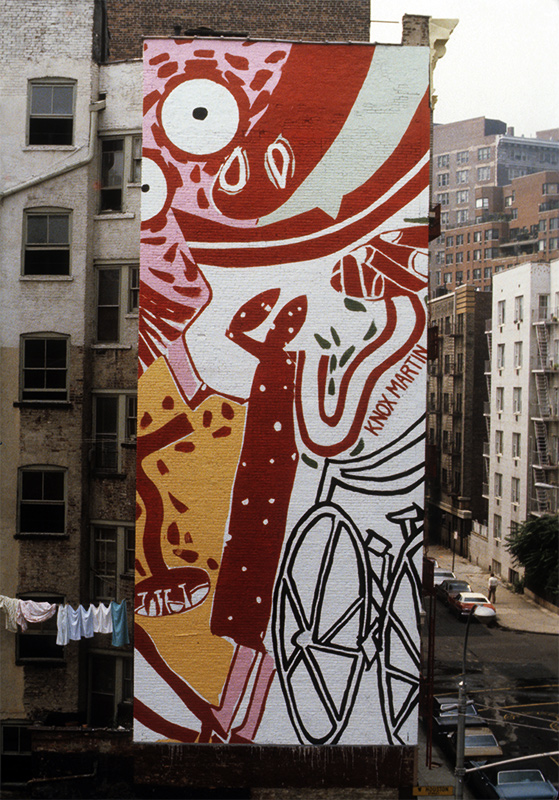
What do you think happened?
She got involved with all of the seepage from a polluted sewer of whatever her friends liked. She had been part of a mass of people, which was postmodernism, where everybody is an artist.
We are so caught up with image, not image that is on the canvas, but the image of the person making the image. The idea of image means more than the act of creation itself. How we are seen as creators is what counts. The action is not nearly as important as the image of the actor. This is part of the great fallout from post-modernism. Too many artists place more importance on being recognized as artists than they do on art they create.
It’s egocentric.
We’ve gotten away from the process. But still the world agrees that Cézanne’s Boy in the Red Waistcoat is art.
But they don’t agree with that. Whose voice do you listen to, some professor someplace or Picasso or de Kooning? In the 50s, you couldn’t see anything de Kooning had, but his work is now valued at four billion dollars.
As you already mentioned, somebody recently paid 120 million dollars for Munch’s Scream, which you feel has no validity whatsoever. So then, is that about you, or is it about the person who paid the money for it?
If you are doing art, if you’re involved with art, if you look at art, if you listen to art, the point is to share that. Yet, you can’t share it. You can go over the fact that the handkerchief falls here, the hand goes over there, pulls this way, the little clock pulls back, the red across her hair is a bridge for the mouth, and this plume does something, and this is like a piece of Bach music down at the bottom. You can rub someone’s nose in it, someone who never wanted to look at it in the first place. Then when you look at it, after a certain point, you can’t stand looking at it anymore because you’re going over the same things. You’re looking at it and are thrilled by it. Art is something you come to and you’re devastated by it. It falls in love with you, and you reciprocate, right? So, when a real artist—I think I am a real artist, alright—when I finish something, I don’t give a rat’s ass who looks at it. I don’t care who sees it. I don’t care if it is exposed or in a museum of whatever have you. I’ve never looked for a gallery or for a museum or for a teaching job. By dint of what I am doing, people come to me and I’m always surprised.
I have a whole new bunch of new drawings. I don’t care if I put a fucking torch to them. I go over them and I’m in love again. The love of art runs through me. I’m talking about the thing that you referred to before, the strange thing that you feel, kind of a haunting thing, when looking at a late self-portrait of Rembrandt, and he’s going, Ha, ha, ha, ha. It is that asset. That fucking thing is talking to me.
But there is art that you might not consider to be art that speaks to others.
No. I can encompass any art. I’ve looked at the world art, every art: Sorolla, Repin from Russia, anybody from England, anybody from France, any artist that’s been published, exposed in the museums, I’ve seen. There isn’t anybody I haven’t seen. I know exactly what they are doing. Could any of Russian art at all be a surprise, or beautiful, or inspiring?
Why can’t there be any art by a Russian that is an expression of that culture?
The amazing thing is what comes together is so subtle and so fine and so funny in its collative way. What are the chances that I, being born in South America, a male, somewhat attractive, somewhat intelligent, wind up in New York City, the center of the art world, as a painter?
I still don’t …
You can’t do painting in California. You can’t do painting in Texas. You can’t do painting in Connecticut. You can’t do painting in Staten Island. It has to be Manhattan, New York City.
Why?
Because I say so. No. You could go into that. It is what you attach yourself to. It is what you yourself think art is. All of England thinks that art lies in Michelangelo. William mother fucking asshole Blake says that Titian’s women are made of chalk, and the men are horrible, and he is a dirty old man because he paints a Venus with the hand at her groin. So that’s Blake’s notion of art. Cézanne is the ultimate artist. Cézanne is the artist that every other major artist went to.
You just said Titian before you were referring to Cézanne. You said Cézanne is the person who … now, every major person went to Titian as well.
They’re interchangeable. It’s the same guy.

But a lot of major people went to Michelangelo, too.
Yeah, alright. Michelangelo has nothing whatsoever to do with art. He was illustrating sculpture and doing it on the Sistine Chapel, a painting, and he hated painting. He loathed it. He despised painting. It used to look pretty good before they cleaned it. When they cleaned it, that showed what it is: illustrative sculpture. Every particle of the background is neuter; it doesn’t do anything with any form. Every form in there is done in 3-D. Three dimensions! That has nothing to do with what Titian was doing, Tintoretto was doing, Veronese was doing, that El Greco was doing, finally, Velázquez was doing.
So what were they doing?
They were doing art. It was based on a fantastic group of paradigms of a geometric poetry that you find in all of Islamic art, which is put together with geometry. One of the finest pieces that has ever been done, a thing that perpetuates itself, jumps the space, falls back, then brings itself forward and the space changes, and each shape and form are altered. And each one is altered over that. And over that there is another movement. Like a great Titian, parts would rhyme with one another. Each corner was handled a certain way. There isn’t anybody in the fucking world today that has even a clue of that. Nobody discusses it. There isn’t anybody I know. The texture of the Kosmos, the entropy is geometric!
You say there’s an underlying geometry. Would you call Islamic art intuitive?
It is like the Ramanujan nested radical structures.
Go on.
The Ramanujan nested radicals are made in such a way that the division of the other is a total surprise. I forget the number that is given. There are magical numbers that are given off that and other proportions that are born of that amazing thing.
I was speaking to a master chess player from Israel, Yuda Oppenheim. We were talking about chess. I felt it was so limited. He talked about José Raúl Capablanca, who was a Cuban chess master. He said that this man, impossibly, would come forth with a thing that had never been created before, a totally new move that was impossible. So the geometry I’m talking about, the structure of art itself, within the structure of itself, gives you a reciprocal thing when it touches the spirit in man, so to speak. There is a blossoming.
It is like a complete circuit. When you create an electrical circuit, you make the connection and the energy runs through it. So the same would be true of art.
Yup.
Is it correct to say that there is a supportive language for art that lies in geometry?
Yup, there is. I think there were old studio secrets that you had to swear to in the studio that you were working with. If you were with Titian’s studio, grinding stuff and mixing colors, and doing backgrounds and laying the stuff out, you’d have an oath.
Doesn’t observation of one’s work have an influence? A lot of people worked in Titian’s studio, in Tintoretto’s studio, in Veronese’s studio.
Is it observable that the drawing of my daughter was done on the rabatment? I mean, look at it. Did you know that?
Did I relate it directly to the rabatment? No. But I related it to how engaging it is, where the forms lie in space, that there is a specific tension running around the forms that is indicative in other art. While I don’t necessarily equate it with something that is geometric, there is a sense of geometry, which elevates the work.
There is geometry in art. Is that how one would determine why people respond to Monet, for example, and his ability to convey a natural sense of light? Now, you look at an impressionist painting by Monet or Pissarro or Sisley and there is this fascination with their capture of light. Without the geometry, is that quality something other than art?
That very fastidious, hard geometry exists in the greatest artists of all time: van Eyck and in every painting by Ingres. That is just part of your palette so to speak. It is not a dominant thing, but it is there. It is important in that it proliferates in the form of the elements that come out of the relationships to each part that gives birth to each part, within each part, which illustrative art doesn’t do. Illustrative art takes an image of some kind and illustrates it, period. It is not concerned with art, but it calls itself art.
There was a lady who collected my work who came here one night and asked why I had a Watteau reproduction on the wall. I said, I’m sorry. What are you going to say? To ask that question I knew that she didn’t understand. I changed the subject as fast as I could. That Watteau is made on the rabatment, exactly. That’s what makes part of the charm.
When Meyer Shapiro came to my studio, there was a portrait I did in oil of Olivia. I had worked this out on a whirling square rectangle, right? And he commented. He didn’t know what it was. Now, I did not expect anybody other than a painter to talk about that painting the way he did. But he went into it. I said that the red makes a bridge, the mouth makes a bridge to the red across the strip of the hair to make that incredible horizontal that goes over to this edge right through to that whole thing and makes it a horizontal for the top.
So you’re describing a structural rationale for art.
Let’s say it this way: Seurat is on the Seine in the park, and he suddenly sees the whole thing without the intervention of any screens. It’s the naked scene. Each object in a strange way you don’t know what the hell it is even. The first time I encountered that I was on a drug, mescaline, and I was in a cab. I looked at the cab driver and I didn’t know what it was. I had no idea what it was. Seurat has that thing.

Are they merely elements in a picture?
No, no, no, no. When you go to Central Park and you look across the park, you see stuff there. In this strange way, it’s like when you label something, you dismiss it. Whatever you label, you dismiss.
Sometimes, if it’s not labeled, it is more easily dismissed.
No. It may not be seen if it’s not labeled. If it’s not labeled, maybe you won’t see it.
You call that painting in back of you Danaë. The moment you called it that you created a reference. Very often that reference will force the viewer to look at it in a more cohesive way, rather than wondering what it is. The word is a trigger. If I see a wonderful scene of people sitting on the grass, I might see Seurat as a result of it.
You see a group of people because of Seurat?
I see a group of people in a specific pictorial way because of Seurat. It is just the same as a swimming pool and Miró.
That’s surface. I’m talking about infinite subtleties along the lines of dress, of manner, of speech. Dylan Thomas writes just what we’re talking about. The poet is working with nobody having the knowledge of what he is doing, fitting the things together. If you label something, you see it. You say, That’s an oak tree. The minute you say it’s an oak tree, it becomes dead metaphor.
So why did you title the painting Danaë?
That is a personal thing. I didn’t even intend to. I would call it Danaë, and I wouldn’t expect anybody to research it. I don’t fucking care.
You called it that. You saw something.
It intrigued me because of the Titian painting.
Would you prefer to call it Untitled?
No, not prefer to call it Untitled. It peaks me personally just to call it Danaë. Ninety-nine percent of the people who come in here say that the name of that painting is Danaë. The painting I’m finishing in there is called She. And the name came out of the poems that I was writing, the Mermaid poems.
Is that good or bad or indifferent?
It just is.
But does the reference give a certain weight?
I don’t care about whether it has weight or not or whatever have you. What if you titled it Art? Everything I do is titled Art. Like my painting, Killing of Whales.
Do you think that someone looking at that painting would not understand that those are whales?
I had a guy who wanted to buy something from me come to my studio last week with his mother. I asked him, Can you talk to me about this painting? He said, Um, I know it is whales. He turned his face away. So I said, Look, the top whale is screaming; he has been harpooned. There is a mother whale breast-feeding the little one, while it is being harpooned. The whale on his back has been hacked up and is shocked and is vomiting blood. The whale in the corner is like a passage from life into the great beyond. The aspects of the water, the shape of the blood, rhymes with this and this and so forth. There are angles and diagonals running through the thing and there are shapes in between that. He’s going, Oh, oh, I see, oh, that’s the mother whale. What the fuck did he see before?
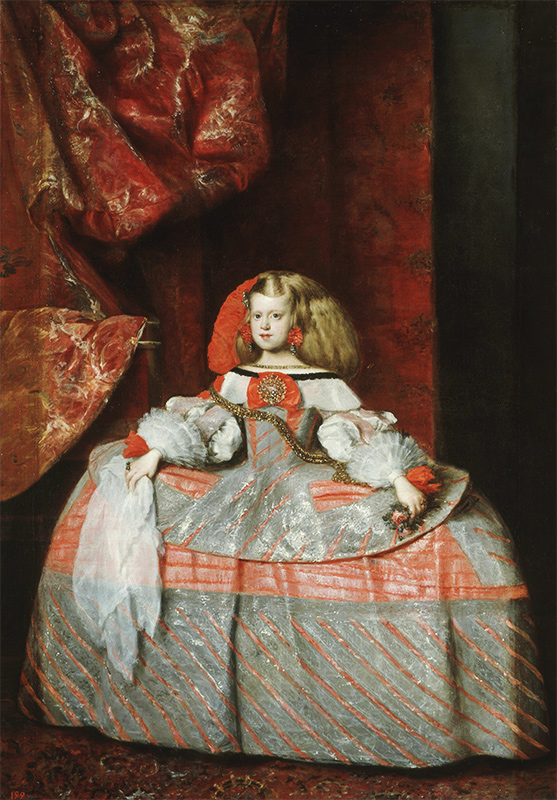
What if that title Whales gives somebody a reference point? You once showed a the painting, María Teresa (1638–1683), Infanta of Spain. The first thing you said was, Now, this is how you paint a princess!
That was his job.
That’s not what I’m talking about. There’s a line from the movie Amadeus where Salieri says, I can write an opera about a king and make him an ordinary man. Mozart writes about an ordinary man and makes him a king. That statement reveals the great distinction between one composer and the other.
If you are commissioned to paint this princess, how are you going to make that princess not look like any ordinary princess and look like a monarch? You employ everything you understand about art to ennoble the subject with the grace and elegance befitting a princess.
But if she is the Infanta, if she is now the princess, and he has painted this woman in a way that reflects her heritage, her lineage, now you’ve got something. If you called that Velázquez painting My Sister, are you going to look at that and say, Gee, you’ve got a regal looking sister there. Are you going to think about it in the same way?
No. Anything you do to it has to change it.
Similarly, anything you name will change the perception of it.
What do you have here with this Cézanne still life ? This is more than the equal of the Velázquez. This is all of art.
Why would that be more than the equal of the Velázquez?
Because it is art.
It is art just because you’re saying it is? There has to be a distinction here.
The Velázquez is as high as you go, right? This is an amazing piece. This is innovation. This triggered a whole world. The whole world at its core is changed—all atoms, particles, everything. The whole thing is changed because of that fucking painting. You can’t get any better than this.
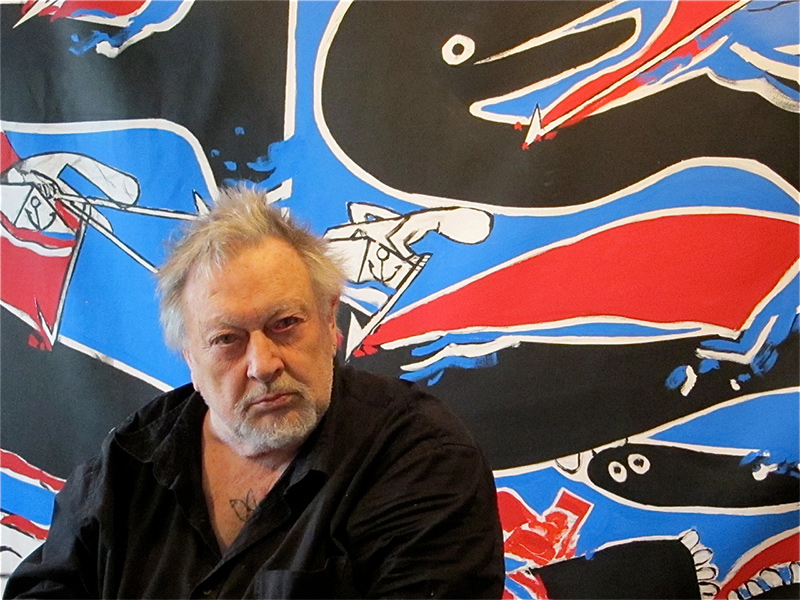
There is a certain inconsistency here.
Cézanne goes someplace else. I see this thing and I’m in love again with art; I’m racked by it. Looking at this thing, I’m home. Like I listen to Mozart, and I’m home. I believe that one of the more elitist things you can say is that art is not for everybody. Or you could say, Fuck everybody else. The thing I’m beginning to realize is that I’ll point to the same things again to students I’ve had for years, and they can’t see it yet.
Can you say in words what you see?
I had a reproduction of an Adriaen Brouwer painting. He was a pupil of Franz Hals and one of the greatest Dutch painters. Years ago, I mentioned Adriaen Brouwer at the Art Students League. Nobody had ever heard of him. Nowadays, at the Art Students League, he is familiar. I had this Brouwer on my wall in the other room and kept looking at it. All of a sudden, after four years, I suddenly saw it. I said, Whoa!
But you had it on the wall before that revelation. You must have put it on the wall in the first place because you’d seen something in it.
Yeah, I had seen the other Brouwers, but I hadn’t seen that one yet.
What did you see?
It just came together in a certain way.
This whole question about the titles flies in the face of your idea that art appears as self-evident. Something that is self-evident doesn’t need words. You see it. Sometimes the title will give reference enough for one to be able to see differently. When you called that painting The Killing of Whales, for example, I could imagine that somebody might say that whale looks like he’s laughing. He looks like he’s happy and there’s just this little heart shape that’s coming out. The moment you say The Killing of Whales, it changes. It represents a statement of deep protest.
One woman said to me she’d buy the picture it if I took the harpoons out.
Well, in that case, there is no response.
De Kooning never titled his own paintings, except for maybe once or twice. Some asshole would title it. One painting is entitled Attic. That terrific painting is a dictionary of de Kooning’s forms: mouths, faces, noses, eyes, profiles of this and that. It has nothing to do with an attic, but some fucking asshole says, It reminds me of my grandmother’s attic. The title stuck. The other one was Excavation. People go, Oh, I see, there is a derrick over here and it’s moving stuff. There’re buildings going up over here. It’s the same thing.
In the picture that’s behind you is a crow. Correct? You wouldn’t call it a raven; you wouldn’t call it a blackbird. You’re calling it a crow. Why the specificity if it’s really just a black form over a white form over a pink form?
You’re talking about nonobjective art.
OK.
Nonobjective art is not dealing with metaphor. For an art for sale, like a Guernica or Pink Angels, you’ve got to take an aspect of reality and alter it so it is changed forever.
What was wrong with naming the de Kooning painting Attic? Would Guernica be better had it been untitled?
No, Guernica is a specific thing done out of the horror that Picasso saw of a town that he knew.
He didn’t see it; he heard about it.
But he knew the town.
But calling it Guernica gave it a certain sense of place in history. When the Nazis were going through his studio, he was asked, Did you do that? Picasso replied, No, you did. His statement is powerful because something happened that inspired him to do it.
Getting back to the question of labeling: If you are looking at a tree—and there’s a sensibility to look at a tree—you begin to relate leaf shape to leaf shape. The spaces in between leaves, one is shaped to another in a tree.
How has your own work changed? You’ve frequently said that nothing’s changed.
Mary Shelley said, Naught exists but mutability. Everything is change. There are certain things that remain the same.
Does the act of creation remain the same?
The act of creation in the hand of an artist is very different from a caveman, is very different from a journalist, is very different from an academician.



